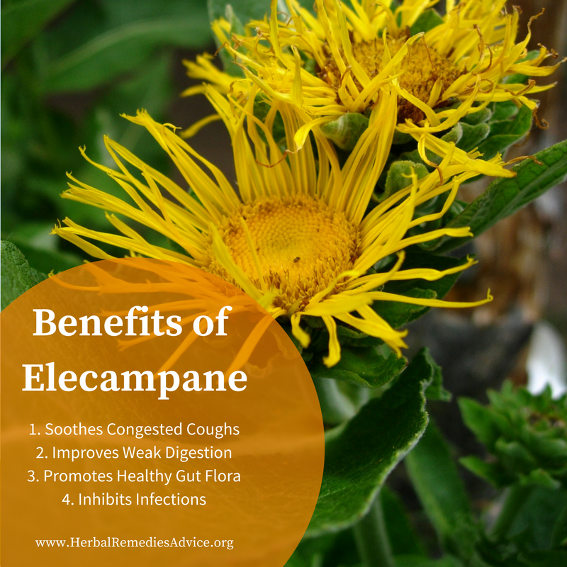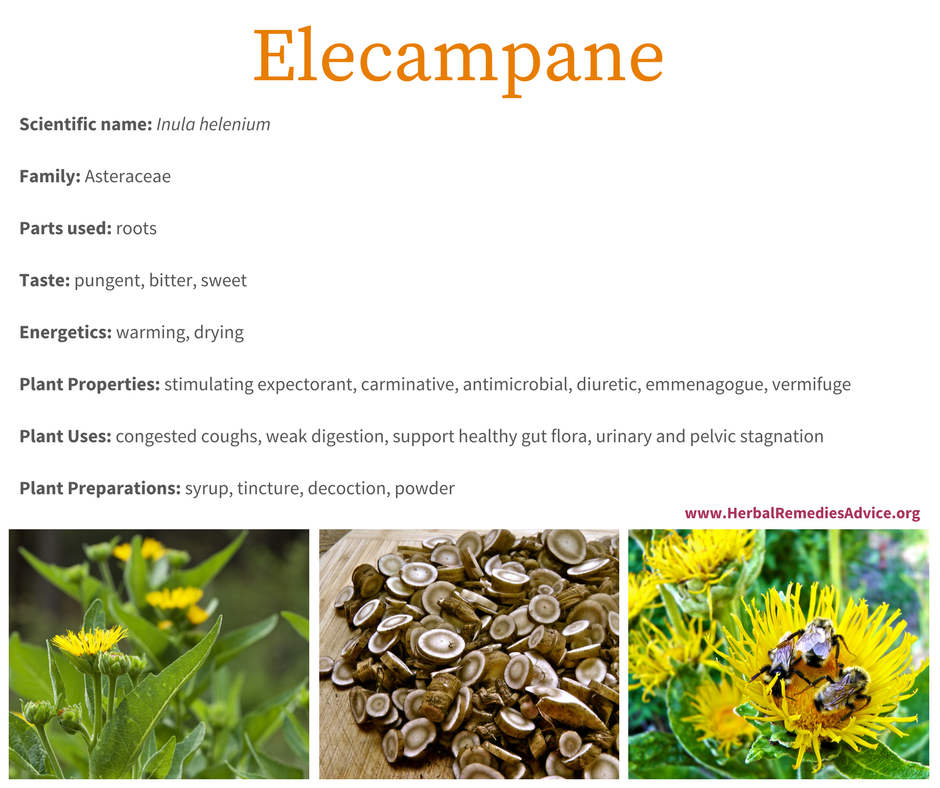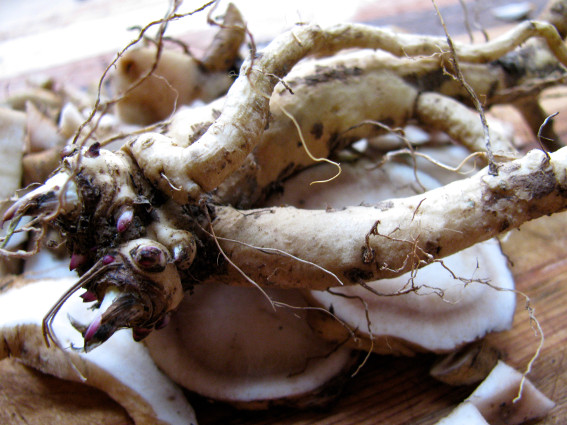Get weekly tips, recipes, and my Herbal Jumpstart e-course! Sign up for free today.
Elecampane Uses
Share this! |
|
There are so many elecampane uses!
It’s famous for coughs but be warned: it doesn’t help ALL types of coughs. Instead, elecampane truly shines for one type of cough in particular (and yes, I’ve got all the details in the episode).
Elecampane root is also totally underrated as a bitter herb to support digestion.
In this episode, I’m sharing my love for this powerful medicinal plant. As a listener, you’ll also get access to my favorite elecampane herbal bitters recipe. (Be sure to download your free, beautifully illustrated recipe card!)
If you have elecampane in your garden, or you simply want to know about elecampane uses, then don’t miss out on all my best tips for getting the most benefits of elecampane root!
After listening in, you’ll know:
► Why elecampane is not the herb to reach for when a cough has certain characteristics
► What type of digestive complaint elecampane can be especially helpful for
► Why elecampane can help you support a healthy gut flora (and how harvest time affects this)
► How to harvest elecampane root without killing the plant
► and much more
►►► To make it easy for you to keep this information organized, I’ve created a beautiful ebook as a companion to this episode. Receive your Elecampane ebook by signing up for my weekly newsletter below.
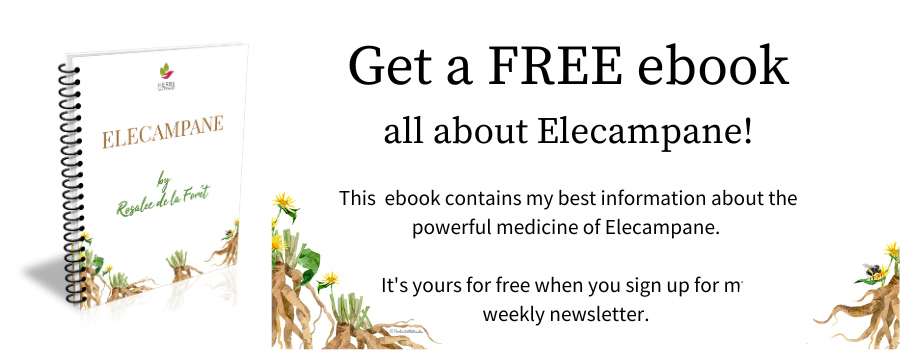
-- TIMESTAMPS -- for Elecampane Uses
- 00:00 - Introduction to elecampane (Inula helenium)
- 03:06 - Elecampane energetics
- 04:35 - Elecampane: A famous cough remedy
- 09:30 - Benefits of elecampane root for digestion
- 12:13 - How to identify elecampane
- 13:23 - Special considerations
- 14:11 - How to work with elecampane
- 15:30 - Elecampane herbal bitters recipe
- 18:19 - How to use your digestive bitters
- 21:34 - Herbal tidbit
Download Your Recipe Card!
l
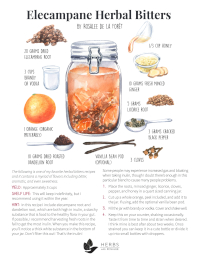
Transcript of the Elecampane Uses Video
Every spring elecampane begins anew. Its leaves break through the soil, reaching up for those sweet rays of sun. If you turn your back on it for a moment, you’ll be surprised to see how much it grows.
In just a couple of months, it will go from ground level to 8 feet or more. Its long leaves unfurl up the tall stalks where a hundred yellow flowers bloom so bright as if to mimic the sun.
In times past elecampane, or Inula helenium, was once called elfin root, perhaps due to the elves which were said to reside under the leaves or perhaps because the root was used to treat poisoned elf arrow wounds. Its species name, helenium, is said to be derived from the belief that Helen of Troy’s tears gave birth to this plant.
Elecampane is native to Europe and Asia and has been used as medicine for thousands of years. It was mentioned in the first and second centuries by all the big western herbal names like Dioscorides in De Materia Medica, by Pliny the Elder, and by Galen of Pergamon.1
Do you have experience with the benefits of elecampane root? I’d love to hear about it in the comments on YouTube or at the bottom of this page. Your comments mean a lot to me! I love cultivating a community of kind-hearted plant-loving folks! Plus, it’s always interesting and insightful to hear the experiences of plant lovers out there. Your suggestion may also help others!
Okay, let’s dive in..
Elecampane Uses: Understanding the Energetics of Elecampane
Elecampane root has a pungent, bitter, and sweet taste. This special combination of tastes make it a strong ally for the lungs and digestion. Elecampane is warming and it gets things moving!
Many of elecampane’s actions can be described as stimulating: a stimulating expectorant, stimulating diuretic, emmenagogue (stimulates the menses), etc. Therefore, it is best suited for stagnant and damp tissues. However, it’s too simplistic to call this a “drying” plant. It also isn’t a simple astringent that tightens and tones lax tissues, but instead it stimulates movement of excretions while simultaneously moving old and stagnant dampness out of the body.
Think of it like this.
There’s a stagnant pool of water filled with muck and grime and other unappealing growth. Elecampane wouldn’t simply remove the obstruction allowing the old water to flow away, it would also stimulate the flow of fresh water restoring health and vitality.
If you’re new to the concepts of herbal energetics and understanding if a plant or a condition is hot or cold or damp or dry then I highly recommend my first book, Alchemy of Herbs.
This bestselling book shows you exactly how to choose herbs that are best for you, based on herbal energetics.
Elecampane Uses: A Famous Cough Remedy
As I mentioned, the benefits of elecampane root are renowned for coughs. And it’s true! Elecampane root has so many benefits for the lungs. And it’s so effective because it doesn’t simply have one action. Instead it’s super complex.
In this section I’m sharing 4 ways that the benefits of elecampane roots help you when you have a cough.
Here’s the thing: Elecampane root is amazing for some coughs but not all coughs!
Elecampane is best for coughs that are wet, cold, and congested. One of the best ways to describe an elecampane cough is boggy!
So, the first benefit of elecampane root for coughs is as a stimulating expectorant which increases the flow of mucus. Herbalist Matt Wood says that in some cases it actually strengthens the cough reflex, which facilitates the release of stagnant and stuck mucus from the lungs.2
It’s long been known that elecampane root is best for congested coughs. Here’s this advice from the King’s American Dispensatory from 1898:
[Elecampane] is a popular remedy in coughs, but is often used without sufficient discrimination; for while it answers an excellent purpose in sub-acute and chronic cases where the lung structure is relaxed and expectoration viscid or too profuse, (as in humid asthma,) it is not suitable for cases of any class where the lungs are irritated or dry–as it then increases the dryness, and gives a feeling of constriction.
In addition to moving stuck mucus and restoring healthy mucus, elecampane root is strongly antimicrobial.
Elecampane is specific to bronchial infections and was historically used for tuberculosis.
An in vitro study found that an extract of the root eliminated 100 percent of MRSA strains; however, no human clinical trials have been performed.3
The third benefit of elecampane root is that it also exerts a mild influence over lymphatic tissues. This can be useful for swollen lymphatic glands of the throat, as well as for the lymphatic tissues in the GI tract (that’s super important so more about that in just a bit).
The fourth benefit of elecampane root for coughs is as an anti-inflammatory herb.
As a 2020 study pointed out, “During the [cold and flu] epidemic season, over 90% of acute wheezing disease is associated with bronchial inflammation”. With this in mind researchers looked at elecampane, in vitro, to determine its anti-inflammatory effects. They concluded, “Our observations justify the traditional use of [elecampane] for a treatment of inflammation-based diseases in the respiratory tract.”4
This was a cool preliminary study, but I don’t want to be misleading.
Addressing inflammation in the body, especially chronic inflammation, isn’t as simple as a this-for-that formula. Instead we need to look for the root causes of the inflammation in order to fully resolve it.
If you’re concerned with chronic inflammation and the many ways this can show up in our bodies, like heart disease, cancer, type 2 diabetes, chronic pain, and more, then you’ll definitely want to check out my free training: How to Use Herbs to Transform Your Health to get More Energy & Vitality – Without Expensive Supplements or a Restrictive Elimination Diet.
You can access this free training by visiting herb-training.com
Okay, so far I’ve shared four ways that elecampane supports a cough.
As a reminder that’s as
- stimulating expectorant for relieving congestion
- antimicrobial
- lymphatic
- anti-inflammatory
As I said before, elecampane is very complex and can work in a variety of ways. It can also be used for stuck mucus in the sinuses or to correct post nasal drip. Herbalist Matt Wood says it is specific to mucus discharge that then causes indigestion, such as post nasal drip.5
A 2021 clinical trial assessed the benefits of a cough syrup for children made with elecampane, honey, mallow, plantain and helichrysum - an interesting formula! In this study half the children were given the syrup and the other half were given a placebo.
The researchers reported that those children taking the herbal syrup “showed an early and significant reduction in night-time and day-time cough scores.”6
Undoubtedly elecampane roots benefit congested coughs, but it’s not simply a cough herb!
Elecampane Uses for Digestion
While the benefits of elecampane root are famous for coughs, elecampane is also a powerful ally for the digestive system.
Energetically, the taste of elecampane points directly to digestion. It has the warming and stimulating properties of the pungent taste, while also containing the stimulating and draining qualities of the bitter taste as well as the nourishing qualities of the sweet taste.
It is specifically used when there are signs of poor digestion with poor absorption, which may energetically be signs of coldness and dampness in the digestive tract.
Signs of cold and damp digestion include poor appetite, mucus in the digestive system, white thick tongue coating, stagnant digestion (where the person eats but feels like the food stays stuck in their stomach), excess gas, and feelings of lethargy and sluggishness.
Remember I mentioned elecampane’s effects on the respiratory system lymph? It also exerts influence on the lymphatic tissue of the GI tract. When these tissues become stagnant, there is poor absorption of nutrients and poor immune system health.
In addition to the stimulating tastes of pungent and bitter, elecampane also has a sweet taste that is due to its extremely high inulin content. Inulin (not to be confused with insulin) is a group of natural polysaccharides, which are large carbohydrate storage molecules commonly found in the roots of plants.
The fresh root of elecampane contains up to 30% inulin polysaccharides.7
These large molecules aren’t broken down by our upper GI tract, but instead pass to the colon where gut bacteria are able to utilize them.
For this reason it is called a prEbiotic, which is a substance that feeds and supports healthy gut flora.
This high inulin content in elecampane is also helpful for people with blood sugar issues, such as type II diabetes. This starch (inulin) slows down sugar metabolism, reducing harmful blood glucose spikes that contribute to insulin resistance.
Inulin may also have antioxidant qualities which can reduce the systemic inflammation often associated with this disease.8
Elecampane’s ability to strengthen digestion and improve absorption helps to restore health for people who are malnourished.
Elecampane is also a vermifuge and has been used against intestinal parasites.
Elecampane Uses for the Stagnation of the Pelvis
Many Eclectic herbal texts report that elecampane is a uterine stimulant that can move dampness or stagnation in the pelvis.9,10,11 This certainly is in line with its more common uses in the respiratory and digestive systems; however, this use is not common among contemporary western herbalists.
The Elecampane Herb
There are about 100 species within the Inula genus, several of which are used as herbal medicine.
I work with the species Inula helenium.
Inula helenium is an herbaceous perennial that can grow up to 10 feet tall. It thrives in sunny to partly sunny conditions with moist soil. It grows easily in gardens and can be found on roadsides and in pastures.
It blooms with yellow daisy-like flowers that are around 3” in diameter. When I water it enough, my garden elecampane will have up to 100 blooms each year.
Elecampane’s simple leaves are large and abundant, measuring up to two feet long.
The abundant roots are creamy white to yellow and are easy to harvest in the garden. While some roots go deep to anchor the plant, many other roots spread laterally. Those are the ones that I harvest. You can easily harvest some of the roots and leave the rest of the plant to keep on living.
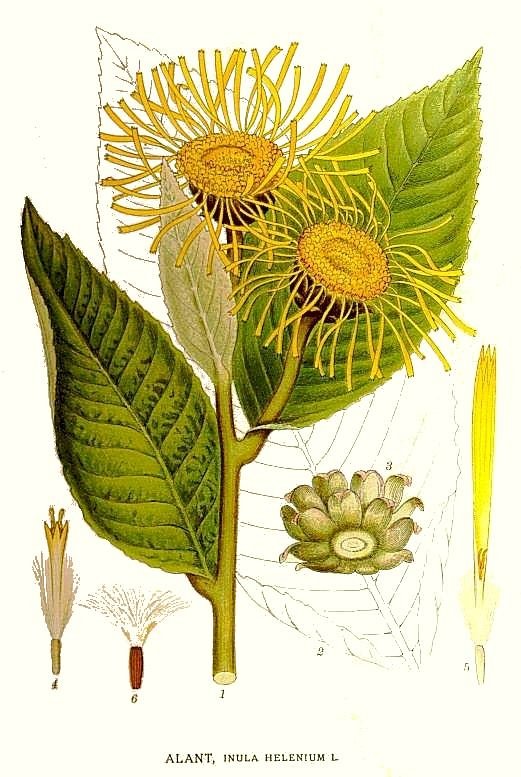
Special Considerations for Elecampane Uses
Before I share about making medicine with elecampane, let’s go over some special considerations to make sure you can work with this plant safely.
- The Botanical Safety Handbook lists elecampane with its highest safety rating.
- However, caution is warranted during pregnancy as it may be a uterine stimulant. (It’s important to note that The Botanical Safety Handbook lists it as safe for pregnancy.)
- It’s always a good idea to start with a small dose and then increase the dose slowly. Large doses may have an emetic or nauseating effect.
- Rarely, contact dermatitis has been reported with this plant. Those with a known sensitivity to plants in the Aster Family may be most susceptible.
Elecampane Uses
You can use both the dried and fresh roots of elecampane. It’s easy to grow in gardens with moisture and sun. It thrives in my zone 4 garden. It doesn’t do well in hot southern climates.
The fresh root can be harvested in the fall after the plant has gone to seed or in the early spring before it puts its energy into the leaves. (I prefer the fall roots). I have grown the same elecampane plant for over a decade. In the fall I gather some of the substantial horizontal roots and leave the rest of the plant to continue growing.
Fresh elecampane root can be infused into honey, macerated in wine (port is lovely), or extracted in alcohol.
The dried roots can be decocted for a tea or syrup or extracted in alcohol.
If you’d like to make powerful herbal medicines from plants that grow around you, then check out our intensive medicine making course, Rooted Medicine Circle. Through this online course you’ll learn the best ways to make many different types of herbal medicine, with us right by your side in live video classes. Visit RootedMedicineCircle.com to get all the details and sign up on the waitlist. We only enroll in January.
Elecampane Herbal Bitters Recipe
One of my favorite ways to enjoy the benefits of elecampane root is with an herbal bitters recipe.
The bitter taste, while often scorned, is making a comeback!
While the standard western diet has done its best to remove all bitter flavor, we now know that tasting bitter foods and substances has a lot of health benefits ranging from supporting digestion to boosting immunity.
And, once you acquire a taste for bitter there is no going back! Meals lacking bitter tastes become bland and too one-dimensional.
Elecampane root is an ideal herb for digestive bitters. Not only is it bitter, it’s also aromatic and warming. PLUS, it has inulin. As I previously shared, this is a starchy substance that is food to the healthy flora in your gut.
In this recipe I include elecampane root and dandelion root, which are both high in inulin.
If possible, I recommend harvesting the fresh roots in the fall to get the most inulin.
When you make this recipe you'll notice a thick white substance in the bottom of your jar. Don't filter this out! That’s the inulin!
Some people may experience increased gas and bloating when taking inulin, though I doubt there's enough in this particular recipe to cause many people problems.
The following is one of my favorite herbal bitters recipes and it contains a myriad of flavors including bitter, aromatic, and even sweetness.
The ingredients are:
- 20 grams dried elecampane root
- 10 grams dried roasted dandelion root
- 10 grams fresh minced ginger
- 5 grams licorice root
- 3 cloves
- 3 grams cracked black pepper
- 1/3 cup honey
- 1 orange (organic preferably)
- 1 vanilla bean pod (optional)
- roughly 3 cups brandy or vodka
To make this, place the roots, minced ginger, licorice, cloves, pepper, and honey in a quart sized jar.
Cut up a whole orange, peel included, and add it to the jar. If using, add the optional vanilla bean pod.
Fill the jar with brandy or vodka. Cover and shake well.
Keep this on your counter, shaking occasionally. Taste it from time to time and strain when desired. I think mine is best after about two weeks. Once strained you can keep it in a cute bottle or divide it up into small bottles with droppers.
This will keep indefinitely, but I recommend using it within the year.
Here’s how to Use Your Digestive Bitters
These bitters can be taken before meals to strengthen your digestion. You could take drops straight from a tincture bottle with a dropper or dilute it a bit in water.
I like to add a spoonful or two to sparkling water.
The dosage is highly variable. The most important thing is to taste the bitters. 15-30 drops or a half to one full teaspoon should do it.
I’m excited to hear what you think of this elecampane herbal bitters recipe! To make it easy for you my team has created a gorgeous free printable recipe card just for you, which you can download above this transcript.
If you enjoyed this video on elecampane uses and this herbal bitters recipe and you value trusted herbal information, then I hope you’ll stick around! The best way to get started is to subscribe on YouTube and your favorite podcast app.
One of the best ways to retain and fully understand something you’ve just learned is to share it in your own words. With that in mind I invite you to share your takeaways with me and the entire Herbs with Rosalee community. You can leave comments on my YouTube channel, at the bottom of this page, or simply hit reply to my Wednesday email. I read every comment that comes in and I’m excited to hear your herbal thoughts about the benefits of elecampane root and this elecampane herbal bitters recipe.
Tired of herbal overwhelm?
I got you!
I’ll send you clear, trusted tips and recipes—right to your inbox each week.
I look forward to welcoming you to our herbal community! Know that your information is safely hidden behind a patch of stinging nettle. I never sell your information and you can easily unsubscribe at any time.
Okay, you’ve lasted to the very end of the show, which means you get a gold star and this herbal tidbit…
So first to summarize…
The
bitter aromatic roots of elecampane make a strong impression on the
lungs and digestion. Stimulating and draining, they remove stagnant
fluids, returning the body to a healthy flowing state.
But that’s the roots. What about those stunning yellow flowers? Well, they certainly have their gifts too!
I often call elecampane the bee hotel because bees love to spend nights nestled in their yellow blooms. Next time you get to be around a flowering elecampane plant, quietly approach the flowers in the evening or early morning to see if there are any buzzing residents.
As far as medicine goes, Asian traditions also use the flowers of various Inula species. Inula japonica flowers have been researched in several studies showing benefits for addressing inflammation as well as some anti-tumor activity.
You can find more information about the Chinese use of elecampane root in the book, Western Herbs According to Traditional Chinese Medicine: A Practitioner’s Guide by one of my teachers, Thomas Avery Garran.
Citations for Elecampane Uses
Click to show/hide.
Rosalee is an herbalist and author of the bestselling book Alchemy of Herbs: Transform Everyday Ingredients Into Foods & Remedies That Healand co-author of the bestselling book Wild Remedies: How to Forage Healing Foods and Craft Your Own Herbal Medicine. She's a registered herbalist with the American Herbalist Guild and has taught thousands of students through her online courses. Read about how Rosalee went from having a terminal illness to being a bestselling author in her full story here.
